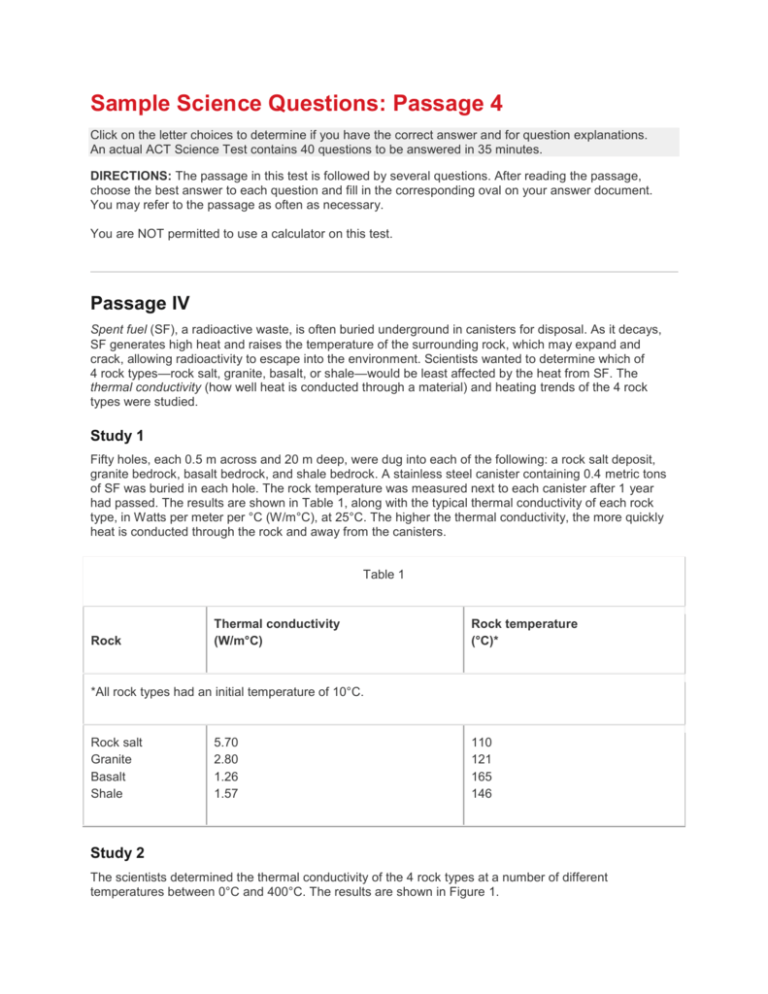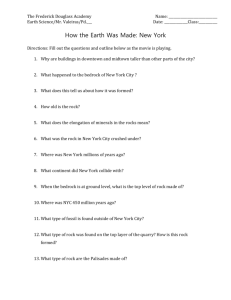Sample Science Questions: Passage 4
advertisement

Sample Science Questions: Passage 4 Click on the letter choices to determine if you have the correct answer and for question explanations. An actual ACT Science Test contains 40 questions to be answered in 35 minutes. DIRECTIONS: The passage in this test is followed by several questions. After reading the passage, choose the best answer to each question and fill in the corresponding oval on your answer document. You may refer to the passage as often as necessary. You are NOT permitted to use a calculator on this test. Passage IV Spent fuel (SF), a radioactive waste, is often buried underground in canisters for disposal. As it decays, SF generates high heat and raises the temperature of the surrounding rock, which may expand and crack, allowing radioactivity to escape into the environment. Scientists wanted to determine which of 4 rock types—rock salt, granite, basalt, or shale—would be least affected by the heat from SF. The thermal conductivity (how well heat is conducted through a material) and heating trends of the 4 rock types were studied. Study 1 Fifty holes, each 0.5 m across and 20 m deep, were dug into each of the following: a rock salt deposit, granite bedrock, basalt bedrock, and shale bedrock. A stainless steel canister containing 0.4 metric tons of SF was buried in each hole. The rock temperature was measured next to each canister after 1 year had passed. The results are shown in Table 1, along with the typical thermal conductivity of each rock type, in Watts per meter per °C (W/m°C), at 25°C. The higher the thermal conductivity, the more quickly heat is conducted through the rock and away from the canisters. Table 1 Rock Thermal conductivity (W/m°C) Rock temperature (°C)* *All rock types had an initial temperature of 10°C. Rock salt Granite Basalt Shale 5.70 2.80 1.26 1.57 110 121 165 146 Study 2 The scientists determined the thermal conductivity of the 4 rock types at a number of different temperatures between 0°C and 400°C. The results are shown in Figure 1. Figure 1 Study 3 The scientists calculated the temperature increase that would be expected over a period of 100,000 yr in each rock type at a point within a site holding buried SF. The results are shown in Figure 2. Figure 2 Table and figures adapted from J. S. Y. Wang, D. C. Mangold, and C. F. Tsang, "Thermal Impact of Waste Emplacement and Surface Cooling Associated with Geologic Disposal of High-Level Nuclear Waste." ©1988 by Springer-Verlag New York Inc. 1. According to Study 2, the thermal conductivity of rock salt measured at a temperature of 500°C would be closest to which of the following values? 1. A. 1.0 W/m°C 2. B. 2.0 W/m°C 3. C. 3.5 W/m°C 4. D. 4.0 W/m°C 2. According to Study 3, if another set of temperatures had been calculated for a time 1,000,000 years in the future, the calculated temperature increase in any of the 4 rock types would most likely be closest to: 1. F. 0°C 2. G. 10°C. 3. H. 20°C. 4. J. 30°C. 3. Welded tuff (another rock type) has a thermal conductivity of 1.8 W/m°C at 25°C. If measurements of the temperature of this rock type adjacent to SF canisters were taken as in Study 1, the recorded temperature would be closest to: 1. A. 100°C. 2. B. 110°C. 3. C. 120°C. 4. D. 130°C. 4. According to the results of Study 1, which of the following best describes the relationship between thermal conductivity and rock temperature? As thermal conductivity increases, the rock temperature recorded adjacent to buried SF canisters: 1. F. decreases only. 2. G. increases only. 3. H. increases, then decreases. 4. J. remains the same. 5. Based only on the information provided, which of the following rock types would be the safest in which to bury SF ? 1. A. Rock salt 2. B. Granite 3. C. Basalt 4. D. Shale 6. Which of the following procedures, in addition to Studies 1, 2, and 3, would best test whether the amount of heat generated by SF is related to the mass of the SF ? 1. F. Following the design of Study 1 but using concrete canisters containing 0.4 metric tons of SF 2. G. Following the design of Study 1 but using stainless steel canisters containing 0.8 metric tons of SF 3. H. Following the design of Study 2 but determining the thermal conductivities of twice as much of each rock type 4. J. Following the design of Study 3 but determining the rock temperatures 0.5 km from the sites of SF burial







